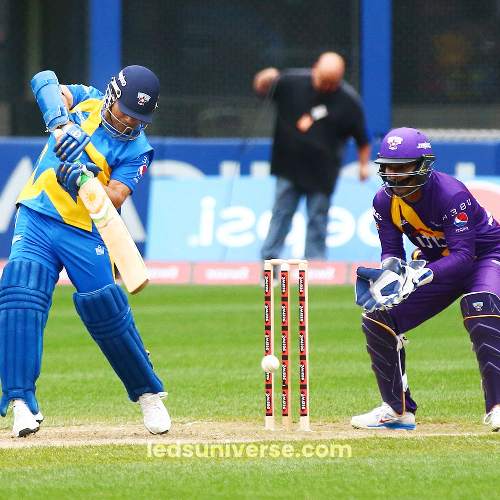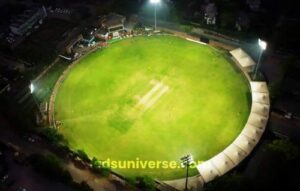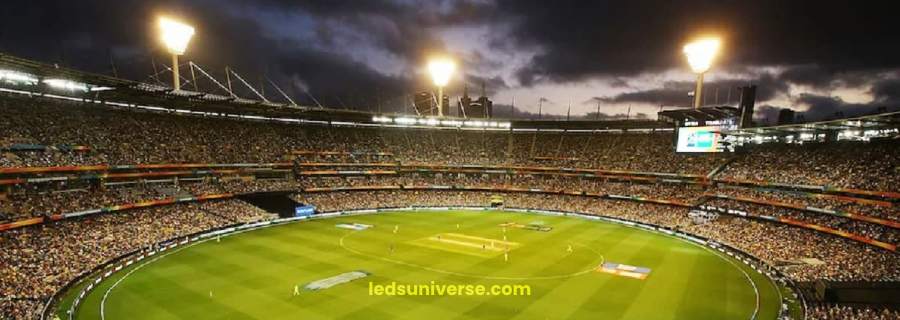With its unparalleled brightness, energy efficiency, and durability, LED lighting is setting new standards for visibility and performance on the field. Dive into how this modern marvel is outshining traditional lighting methods, ensuring every match is played in perfect light, no matter the time or weather.
Cricket is a sport that demands more than just technical skill and strategic acumen; it also requires the best possible playing conditions to ensure a fair and enjoyable game. The performance of players can be significantly impacted by the environment in which they play, including factors such as lighting, pitch quality, and weather conditions. In professional and amateur settings alike, achieving optimal playing conditions through proper lighting helps maintain the integrity of the game, enhances player performance, and ensures an engaging experience for spectators.
Reach out for free lighting consultation
Table of Contents
ToggleThe shift towards LED technology represents a significant advancement in how cricket fields are lit, driven by the need for better visibility, energy efficiency, and long-term cost savings.
One of the primary advantages is their ability to deliver bright, white light that mimics natural daylight. This is crucial for cricket, a sport where the visibility of the ball is paramount. The clarity provided by LED lights enhances players’ ability to track the ball, particularly during high catches and long hits, which can be challenging under less intense lighting conditions.
Unlike older lighting technologies that often resulted in uneven illumination and dark spots—commonly referred to as the “zebra effect”—LED floodlights are engineered to provide uniform light distribution across the entire field. This eliminates areas of darkness and ensures that every corner of the cricket ground is well-lit. The improved coverage not only enhances gameplay but also provides a better viewing experience for spectators.
LED floodlights are also highly energy-efficient. They consume a fraction of the power required by traditional lighting solutions, such as metal halide or high-pressure sodium lamps. This efficiency translates into substantial cost savings on electricity bills, making LED lights an economically attractive option for cricket clubs and stadiums. Additionally, LED floodlights have a longer lifespan compared to traditional bulbs, reducing the frequency of replacements and maintenance needs. This longevity further contributes to their overall cost-effectiveness.

Before the widespread adoption of LED technology, cricket fields were predominantly illuminated by metal halide or high-pressure sodium lamps. These traditional lighting methods, while effective in providing the necessary illumination, had several limitations that LED technology has since addressed.
Metal halide lamps, for instance, were known for their bright, white light but were also associated with high energy consumption and frequent maintenance. They took longer to reach full brightness and had a shorter operational lifespan, which could lead to increased downtime and higher long-term costs. High-pressure sodium lamps, on the other hand, were more energy-efficient but emitted a distinctive orange light that was less ideal for visual clarity and color rendering.
In contrast, LED floodlights offer instant full brightness with no warm-up time, ensuring that the field is illuminated immediately when the lights are turned on. This feature is particularly beneficial for cricket matches that may be played in varying light conditions or require sudden changes in lighting. Additionally, LEDs provide excellent color rendering, which helps players distinguish between different colors and track the ball more effectively.
The energy efficiency of LEDs also sets them apart from traditional lighting technologies. While metal halide and high-pressure sodium lamps are relatively energy-intensive, LED floodlights use a fraction of the power to achieve the same or even better illumination levels. This efficiency not only reduces operational costs but also contributes to environmental sustainability by lowering the overall carbon footprint of the cricket field.
Moreover, the durability of LED floodlights adds to their appeal. They are designed to withstand harsh environmental conditions, including extreme temperatures, moisture, and dust. This resilience ensures that the lights remain operational and effective over time, even in challenging weather conditions.
Proper placement and angling of lights are crucial elements in ensuring effective cricket field illumination. The strategic positioning of lights affects not only the visibility and quality of play but also the overall safety and comfort of players and spectators.
In the past, cricket fields were typically illuminated by tall poles with spotlights mounted on top. These poles, strategically positioned around the field, were designed to provide broad coverage and avoid shadows. However, modern cricket stadiums use advanced configurations to enhance the lighting experience further.
For professional cricket stadiums, lights are generally installed at a height of approximately 30 to 50 meters. This elevation is essential for achieving a wide spread of light while minimizing direct glare that could affect players’ vision. The height ensures that the light is distributed evenly across the field, preventing dark spots and providing consistent illumination throughout the playing area.
The configuration of lighting poles is equally important. Most stadiums employ a combination of high-mast poles, each equipped with several high-power floodlights. This arrangement allows for a more comprehensive coverage of the field, ensuring that every section, from the pitch to the outfield, is well-lit. The number and placement of these poles are meticulously planned to balance light distribution and avoid creating areas of uneven illumination.

The angle at which the lights are positioned plays a crucial role in achieving optimal illumination on the cricket field. The lighting angles are meticulously calibrated to ensure that the ball is visible from every position on the field. This is particularly important in cricket, where the ball can travel at high speeds and at various heights.
Proper angling helps to reduce shadows and minimize glare, which can be disruptive to players. Shadows can affect a player’s ability to judge the ball’s trajectory, and excessive glare can cause visual discomfort. Therefore, the lights are positioned at specific angles to ensure that light reaches every corner of the field uniformly.
Adjustments to lighting angles are sometimes necessary to accommodate different game formats or changing weather conditions. For instance, during evening matches or when the sky is overcast, adjustments may be made to increase the intensity of the light. This flexibility ensures that the field remains well-lit regardless of the time of day or weather conditions.
Additionally, regular maintenance and recalibration of the lighting system are essential to ensure continued effectiveness. Over time, fixtures may shift or become misaligned, affecting the overall illumination. Routine checks and adjustments help maintain the high standards of visibility required for professional cricket.
Beyond height and angle, several other design considerations impact cricket field lighting. The distance between lighting poles, the wattage of the floodlights, and the type of fixtures used all contribute to the quality of illumination. For example, high-wattage LED floodlights are often preferred for their ability to provide bright, consistent light over large areas.
The design also needs to consider the impact of light spill and glare on surrounding areas, including neighboring properties. Modern lighting solutions often incorporate features to minimize light spill, ensuring that the focus remains on the field and does not disturb the surrounding environment.
Safety and security are paramount in cricket field lighting. Proper lighting is essential not only for gameplay but also for ensuring the safety of players and spectators. High-quality LED floodlights are designed with features that enhance safety on the field. They are equipped with robust, weather-resistant housings that protect against the elements, including rain and high winds, ensuring that the lights remain functional in various weather conditions.
LED floodlights are designed to withstand harsh environmental conditions. Their weather-resistant housings protect against moisture and dust, while their durable construction ensures that they can operate effectively in high winds and extreme temperatures. This resilience is crucial for maintaining continuous illumination during adverse weather conditions.
Additionally, modern cricket field lighting systems include features such as emergency lighting and automated control systems. Emergency lighting ensures that the field remains illuminated during power outages, allowing for quick and safe evacuation if necessary. Automated control systems help in managing light levels and angles, making it easier to adjust the lighting as needed for different phases of the game or changing weather conditions.

Cricket fields often face environmental challenges that can affect lighting. Weather conditions, such as rain or fog, can impact the effectiveness of the lighting. Advanced LED floodlights are designed to be highly durable and resistant to environmental factors. They are typically rated for high temperatures and are equipped with protective features to prevent damage from moisture and dust.
In addition to durability, LED lights are energy-efficient and environmentally friendly. They consume less power compared to traditional lighting sources, reducing the overall carbon footprint of the facility. This makes them a sustainable choice for cricket fields and stadiums, aligning with global efforts to reduce energy consumption and environmental impact.
The lux level, which measures the intensity of light, is a critical factor in cricket field lighting. For professional cricket matches, a high level of illumination is required to ensure that the ball remains visible at all times. According to international standards, the minimum lux level for a professional cricket field should be around 1,200 lux. This ensures that the field is well-lit, providing clear visibility for players, umpires, and spectators.
Different areas of the field may require varying lux levels. For example, the pitch area, where most of the action takes place, might need higher lux levels compared to the outfield. LED floodlights are capable of delivering these precise illumination levels, making them suitable for both day and night matches.
Maintaining cricket field lighting systems is essential for ensuring their long-term performance. LED floodlights have a longer lifespan compared to traditional lighting sources, reducing the frequency of replacements. However, regular maintenance is still required to keep the system in optimal condition.
Routine checks should include inspecting the fixtures for any signs of wear or damage, ensuring that the lenses are clean and free from obstructions, and verifying that the lighting angles remain properly adjusted. Proper maintenance not only extends the life of the lighting system but also ensures consistent performance throughout its operational life.
LED floodlights have revolutionized cricket field lighting with their energy efficiency, durability, and ability to provide uniform illumination. Proper placement, angling, and maintenance of these lights are essential for creating a safe and enjoyable playing environment. As cricket continues to evolve, advancements in lighting technology will undoubtedly enhance the game, allowing players and fans to experience the sport at its best, regardless of the time of day or weather conditions.